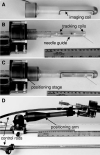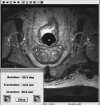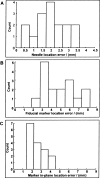Transrectal prostate biopsy and fiducial marker placement in a standard 1.5T magnetic resonance imaging scanner
- PMID: 16406885
- PMCID: PMC3299542
- DOI: 10.1016/S0022-5347(05)00065-0
Transrectal prostate biopsy and fiducial marker placement in a standard 1.5T magnetic resonance imaging scanner
Abstract
Purpose: We investigated the accuracy and feasibility of a system that provides transrectal needle access to the prostate concurrent with 1.5 Tesla MRI which previously has not been possible.
Materials and methods: In 5 patients with previously diagnosed prostate cancer, MRI guided intraprostatic placement of gold fiducial markers (4 procedures) and/or prostate biopsy (3 procedures) was performed using local anesthesia.
Results: Mean procedure duration was 76 minutes and all patients tolerated the intervention well. Procedure related adverse events included self-limited hematuria and hematochezia following 3 of 8 procedures (all resolved in less than 1 week). Mean needle placement accuracy was 1.9 mm for the fiducial marker placement studies and 1.8 mm for the biopsy procedures. Mean fiducial marker placement accuracy was 4.8 mm and the mean fiducial marker placement accuracy transverse to the needle direction was 2.6 mm. All patients who underwent the procedure were able to complete their course of radiotherapy without delay or complication.
Conclusions: While studies of clinical usefulness are warranted, transrectal 1.5 T MRI guided prostate biopsy and fiducial marker placement is feasible using this system, providing new opportunities for image guided diagnostic and therapeutic prostate interventions.
Figures








Comment in
-
The continuing search for meaningful prognostic information from prostate biopsy.J Urol. 2006 Jan;175(1):16-7. doi: 10.1016/S0022-5347(05)00256-9. J Urol. 2006. PMID: 16406862 No abstract available.
Similar articles
-
Design of a novel MRI compatible manipulator for image guided prostate interventions.IEEE Trans Biomed Eng. 2005 Feb;52(2):306-13. doi: 10.1109/TBME.2004.840497. IEEE Trans Biomed Eng. 2005. PMID: 15709668 Free PMC article.
-
Initial clinical experience with real-time transrectal ultrasonography-magnetic resonance imaging fusion-guided prostate biopsy.BJU Int. 2008 Apr;101(7):841-5. doi: 10.1111/j.1464-410X.2007.07348.x. Epub 2007 Dec 5. BJU Int. 2008. PMID: 18070196 Free PMC article.
-
Single-center experience in prostate fiducial marker placement: technique and midterm follow-up.J Vasc Interv Radiol. 2014 Jul;25(7):1125-1132.e1. doi: 10.1016/j.jvir.2014.03.017. Epub 2014 Apr 29. J Vasc Interv Radiol. 2014. PMID: 24788207
-
Transperineal biopsy devices in people with suspected prostate cancer - a systematic review and economic evaluation.Health Technol Assess. 2024 Oct;28(60):1-213. doi: 10.3310/ZKTW8214. Health Technol Assess. 2024. PMID: 39364806 Free PMC article.
-
Safety and morbidity of first and repeat transrectal ultrasound guided prostate needle biopsies: results of a prospective European prostate cancer detection study.J Urol. 2001 Sep;166(3):856-60. J Urol. 2001. PMID: 11490233 Review.
Cited by
-
A workspace-orientated needle-guiding robot for 3T MRI-guided transperineal prostate intervention: evaluation of in-bore workspace and MRI compatibility.Int J Med Robot. 2013 Mar;9(1):67-74. doi: 10.1002/rcs.1430. Epub 2012 Apr 10. Int J Med Robot. 2013. PMID: 22492680 Free PMC article.
-
Magnetic resonance imaging compatible robotic system for fully automated brachytherapy seed placement.Urology. 2006 Dec;68(6):1313-7. doi: 10.1016/j.urology.2006.08.1089. Urology. 2006. PMID: 17169653 Free PMC article.
-
Fiducial marker for prostate radiotherapy: comparison of 0.35- and 0.5-mm-diameter computed tomography and magnetic resonance images.Radiol Med. 2017 Mar;122(3):204-207. doi: 10.1007/s11547-016-0715-5. Epub 2016 Dec 15. Radiol Med. 2017. PMID: 27981486 Clinical Trial.
-
System Integration and Preliminary Clinical Evaluation of a Robotic System for MRI-Guided Transperineal Prostate Biopsy.J Med Robot Res. 2019 Jun;4(2):1950001. doi: 10.1142/S2424905X19500016. Epub 2018 May 15. J Med Robot Res. 2019. PMID: 31485544 Free PMC article.
-
Design of a novel MRI compatible manipulator for image guided prostate interventions.IEEE Trans Biomed Eng. 2005 Feb;52(2):306-13. doi: 10.1109/TBME.2004.840497. IEEE Trans Biomed Eng. 2005. PMID: 15709668 Free PMC article.
References
-
- Yu KK, Hricak H. Imaging prostate cancer. Radiol Clin North Am. 2000;38:59. - PubMed
-
- Wefer AE, Hricak H, Vigneron DB, Coakley FV, Lu Y, Wefer J, et al. Sextant localization of prostate cancer: comparison of sextant biopsy, magnetic resonance imaging and magnetic resonance spectroscopic imaging with step section histology. J Urol. 2000;164:400. - PubMed
-
- Cormack RA, Kooy H, Tempany CM, D'Amico AV. A clinical method for real-time dosimetric guidance of transperineal 125I prostate implants using interventional magnetic resonance imaging. Int J Radiat Oncol Biol Phys. 2000;46:207. - PubMed
-
- D'Amico AV, Tempany CM, Cormack R, Hata N, Jinzaki M, Tuncali K, et al. Transperineal magnetic resonance image guided prostate biopsy. J Urol. 2000;164:385. - PubMed
-
- Cormack RA, D'Amico AV, Hata N, Silverman S, Weinstein M, Tempany CM. Feasibility of transperineal prostate biopsy under interventional magnetic resonance guidance. Urology. 2000;56:663. - PubMed
Publication types
MeSH terms
Grants and funding
LinkOut - more resources
Full Text Sources
Other Literature Sources
Medical

